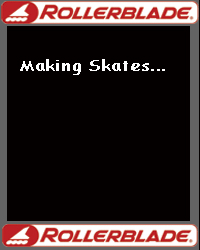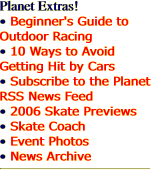Planet Column > Skate Coach
by Kathy McSparran Top 10 Real World Skate Tips
Not all road snakes are made of tar 
 1. Use It or Lose It 1. Use It or Lose It
Keep your head up ... or you may lose it! Remain alert at all times. If you're not watching, you won't be able to react to those obstacles (small and large) that the trail may throw your way.
2. Attack Hazards With Scissors
When the trail gets rough, take out your scissors! Push one skate forward and the other one back. This is the scissors position. Use it to negotiate rough pavement, gravel or small twigs. It will give you more stability. If whatever you are going over is slowing you down, shift your weight to your back skate. This will keep you from pitching forward over your toe wheels. 3. Water Hazards
Avoid wet surfaces. Sometimes they are skate-able, sometimes they are not. The smoother the surface, the more dangerous it will be when wet. (A newly mopped floor at a grocery store could easily launch you through a few display racks.) When you must skate on a wet surface, avoid skating hard until your wheels stop leaving wet stripes on the pavement. ... Standing water is worse. If it gets in your bearings, it could cause them to rust, which will ruin them. 4. Climbing Kilimanjaro
When skating uphill, point your toes out so your feet form a "V" and maintain your forward momentum with short quick strides. 5. Downhill Danger
Do not launch yourself downhill unless you are sure you can handle it. Hills are deceptive. What looks easy from the top can feel completely insane half way down. Size up the hill carefully. Is the pavement good? Is there a curve or an intersection (!) at the bottom that could be difficult to negotiate at high speed? If you have any doubts at all, walk down the hill first! Then, starting from the bottom, attack the hill by fractions, gradually moving up higher. Only skate that portion of the hill which you can do safely and in complete control. 6. Miss Manners
Skate to the right, pass on the left. That's basic trail etiquette. Say "passing on the left" when approaching someone from behind. And smile. Be an ambassador for skating so we will continue to be welcomed on trails and elsewhere. 7. Nice Doggie?
Even a small dog can prove hazardous. All it has to do is to jump out in front of you — or stretch its leash across the trail — to send you flying. When you see a dog approaching, slow down. Smile and make eye contact with the owner (if there is one). The owner will likely respond by shortening the dog's leash or otherwise showing you that Fido is under control. If the dog is unleashed or beyond the control of the owner, stop skating or step off the trail onto gravel or grass. That way if the little bugger jumps up on you, your wheels won't roll out from under you. 8. Snakes and Stuff
Beware of wires, hoses, cables and ... yes, even snakes. I, Skate Coach, have encountered all of these at one time or another. Beginners should stop and step around such obstacles. Intermediates can leap over them one foot at a time. Advanced skaters can jump over them ... except for the snakes. Give them a wide berth! 9. Scouting Party
Skate Coach realizes that bicycles represent a backward stage in the evolution of wheeled transportation. Nonetheless, she endorses the use of these anachronistic devices when scouting new skate routes or trails. Astride one of these sturdy (if lumbering) contraptions, skaters can survey new trails for hazards, such as broken pavement, sprinkler-borne puddles and precipitous downhills. 10. Talking Skates
When your skates talk, listen! Grinding sounds may be a sign of worn or dirty bearings. Rattling may be a sign of a loose axle, wheel or frame bolt ... (or maybe it's that darn snake again!) (Always carry a multipurpose skate tool for roadside repairs.) - Got a trail skating tip to add to the list? Post it in the Skate Coach discussion.
- Got a question for Skate Coach ... send it to Kathy!
Related reading • Go to Beginner's Guide to Inline Skating. • Go to more of Kathy's Skate Coach columns. Kathy McSparran is the director of Phoenix Inline, an Arizona skate school. She holds five IISA teaching certifications: Level 1 (Beginners & Advanced Beginners), Level 2 (Intermediates & Advanced Intermediates), BladeFitnessTM, Freestyle Dance and Fitness Inline Trainer. Still feel like you need some help? Most certified instructors offer instruction on how to handle typical obstacles found on your local trails. Use the new USSG zip-code locator to find an instructor near you. (posted April 14, 2006) | 





